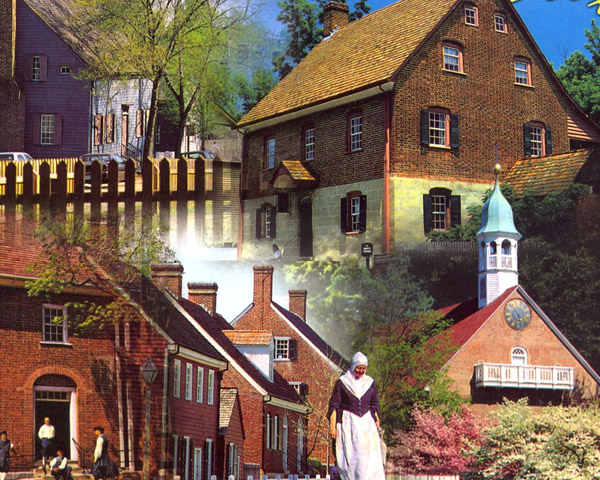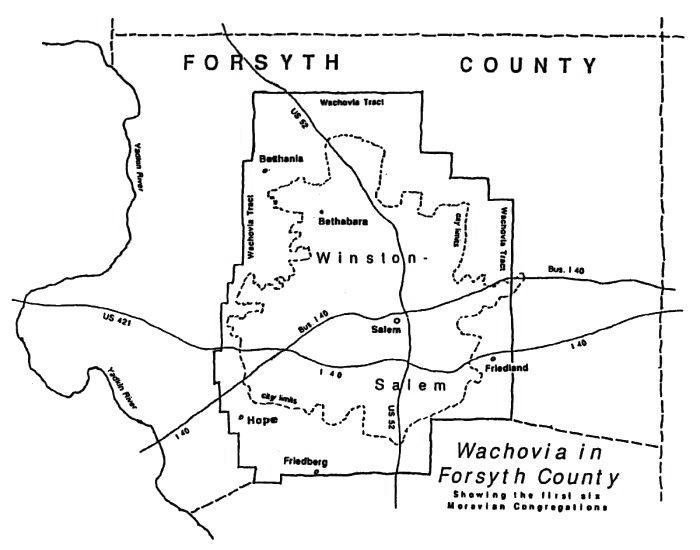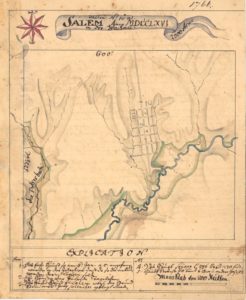Some quick points about your surroundings to provide perspective and enhance appreciation.*
The Beginnings of the Southern Province
The story of the Southern Province begins with the Moravians in North Carolina, as they carve out of the wilderness a suitable environment “to serve their neighbors, establish a town where the Moravian ideals of Christian living might be practically realized, and to preach the Gospel to the Indians.” *
Wachovia (Die Wachau) is the tract of 100,000 acres of land in the British colony of North Carolina, purchased by the Moravians from Lord John Carteret, the 2nd Earl of Granville, in 1753. Bishop Spangenberg travelled from Germany in 1752 to tend to administration of Bethlehem, PA and to select and obtain land for a settlement in North Carolina. The new settlement was permitted to be established as Dobbs Parish under the Church of England, as required, prior to the Revolution.
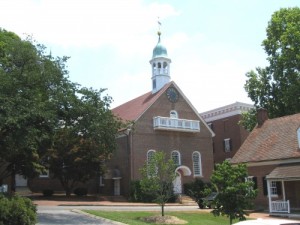 Salem is the central (but, not the first) settlement and economic center of the original Wachovia tract. On Jan. 6, 1766, trees were felled to prepare a sight for the first of five houses along Main St. A Gemeinhaus was completed in 1770, with the Salem congregation organized in 1771. The current Home Moravian Church was built in 1800.
Salem is the central (but, not the first) settlement and economic center of the original Wachovia tract. On Jan. 6, 1766, trees were felled to prepare a sight for the first of five houses along Main St. A Gemeinhaus was completed in 1770, with the Salem congregation organized in 1771. The current Home Moravian Church was built in 1800.
The Home Church sanctuary is open for interpretation (tours) every afternoon in the summer.
The other first five congregations of Wachovia are:
Bethabara was the first settlement, where 15 single brothers from 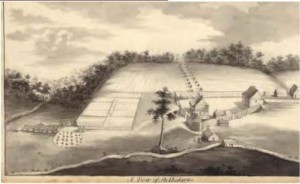 Bethlehem landed on Nov. 17, 1753. The 1788 Gemeinhaus and many other structures are part of Historic Bethabara Park (follow this link http://www.cityofws.org/departments/recreation-parks/historic-bethabara/about-bethabara and click on “visit”) “Bethabara” is a Hebrew word meaning “House of Passage”; it was chosen because of Bethabara’s role as the initial village prior to the founding of the towns of Bethania and Salem and the settlement of the rest of the Wachovia tract.
Bethlehem landed on Nov. 17, 1753. The 1788 Gemeinhaus and many other structures are part of Historic Bethabara Park (follow this link http://www.cityofws.org/departments/recreation-parks/historic-bethabara/about-bethabara and click on “visit”) “Bethabara” is a Hebrew word meaning “House of Passage”; it was chosen because of Bethabara’s role as the initial village prior to the founding of the towns of Bethania and Salem and the settlement of the rest of the Wachovia tract.
Bethania was the second town, but the first planned settlement, established in 1759 as a self-sufficient farming community which allowed both Moravian and non-Moravian settlers. Surveyor Christian Philip Gottleib Reuter designed Bethania to withstand the challenges and dangers of the often hostile frontier landscape during the tumultuous years of the French and Indian Wars. Borrowing from town designs used in Medieval Europe, Reuter clustered the individual home lots in the center of the 2,500 acres that comprised the Bethania Town Lot and surrounded these residential lots with land segregated into orchard lots, bottom land lots, and upland lots. Tour daily at The Historic Bethania Visitor Center, including Alpha Chapel, Wolff-Moser House, and Moravian Book and Gift Shop.
The South Fork society received more settlers from Heidelberg, PA in 1771, to the point that a congregation was formed in 1773 as Friedberg.
A group of Germans from Broadbay, Maine moved to the southeastern corner of Wachovia in 1769 and formed the Friedland congregation in 1780.
Four families moved to the western part of Wachovia in 1772 and joined the preaching at the Douthit house. This nucleus formed the Hope congregation in 1780.
“Old Salem” is the 20th century name given to the historic district that encompasses much of the 1766 planned village of Salem.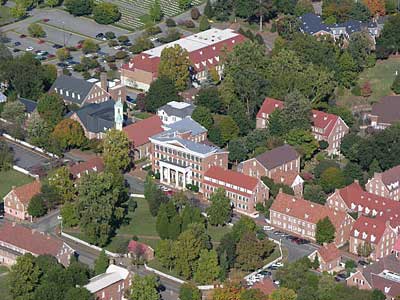
“Old Salem Museum and Gardens” is the name of the non-profit corporation that preserves, restores, researches, reconstructs, educates, displays, and re-enacts much of the daily life of the Salem Moravians in the 18th and 19th centuries. Many of the restored or reconstructed homes and structures in Salem are open for ticketed tours.
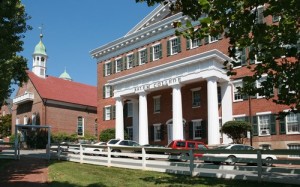 Salem College and Academy offers both a residential high school program, originally, Salem Female Academy, and “a liberal arts college for women.” Among Wachovia’s early residents were 16 girls and women who walked more than 500 miles from Bethlehem, Pennsylvania to join the new community in 1766. One of them was 17-year-old Elisabeth Oesterlein, who would become the first teacher of what is now Salem College – a girl’s school, formed in Salem in 1772.
Salem College and Academy offers both a residential high school program, originally, Salem Female Academy, and “a liberal arts college for women.” Among Wachovia’s early residents were 16 girls and women who walked more than 500 miles from Bethlehem, Pennsylvania to join the new community in 1766. One of them was 17-year-old Elisabeth Oesterlein, who would become the first teacher of what is now Salem College – a girl’s school, formed in Salem in 1772.
Winston-Salem is the result of a merger of two towns in 1913. Winston was established in 1849, when Stokes County was divided, and the new County of Forsyth (which surrounded and encompassed the Wachovia tract) needed a county seat. Rather than have the courthouse in the town of Salem, the Moravians sold 51 1/4 acres for Winston, just at the top of the hill, to the north, for $256.
* Historical information about Salem, NC from With Courage for the Future; the story of the Moravian Church, Southern Province, by C. Daniel Crews and Richard Starbuck, 2002, Moravian Church in America, Southern Province


